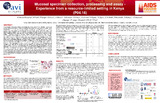| dc.identifier.citation | G.S. Omosa-Manyonyi 1 , B. Farah 1 , P. Bergin 2 , O. Anzala 1 , J. Gilmour 3 , G. Ouattara 1 , G. Mutua 1 , J. Lehrman 4 , H. Ogutu 1 , S. Ogola 1 , C. Verlinde 3 ,R.Ndambuki 1 ,E.Mutisya 1 ,K.Chinyenze 3 , J. Nyange 1 ,R.Langat 1 ,D.Laufer 3 ,H.Park 3 ,andP.Fast,2013.Mucosal Specimen Collection, Processing and Assay— Experience from a Resource-Limited Setting in Kenya,Kenya AIDS Vaccine Initiative (KAVI), University of Nairobi, Nairobi, Kenya; 2 Imperial College, London, United Kingdom (Great Britain); 3 International AIDS Vaccine Initiative (IAVI), United Kingdom (Great Britain); 4 International AIDS Vaccine Initiative (IAVI), New York, NY, USA. | en_US |
| dc.description.abstract | Background:
HIV-1 infection occurs most commonly through
sexual intercourse. Induction of mucosal immune responses will
likely be necessary for an effective HIV vaccine. KAVI embarked
on building capacity for mucosal immunological work and dis-
seminating this to other African research sites.
Methods:
With support from IAVI, KAVI clinical and laboratory
teams designed SOPs for collection, processing and assay of cells
and secretions from gastrointestinal, genital and upper respira-
tory mucosal surfaces over the course of 4 years and several
studies. Specimens analyzed for humoral immune responses in-
cluded saliva, nasal turbinate, nasopharyngeal, cervical-vaginal
and rectal secretions. Cervical-vaginal and rectal cytobrush
samples, and rectal and sigmoid biopsies were stained and ana-
lyzed by flow cytometry. Participants were free to opt out of any
collection. Reasons for refusal and other acceptability/tolerability
data were collected. Depending on acceptability/tolerability and
assay results, collection methods were dropped or SOPs im-
proved as needed. A curriculum was developed for training other
African sites involved in HIV research on mucosal sample col-
lection and processing.
Results:
Four mucosal studies were conducted at KAVI, one in-
volving participants from three HIV vaccine trials. Repeated mu-
cosal sampling in both high and low risk participants was
generally well accepted/tolerated (AIDS Vaccine 2010 and 2012,
P10.07 and P122 respectively). Cellular and humoral immune re-
sponses to HIV were detectable in various mucosal compartments
including relatively easier sampling sites like the mouth and nose.
One site in Rwanda received training and subsequently conducted
a mucosal study; training of more sites is being planned.
Conclusion:
Mucosal sample collection and processing from
various mucosal compartments and by various sampling tech-
niques is possible in a resource-limited setting. HIV-relevant
immunological responses are detectable in both genital and non-
genital mucosal compartments. South-to-south collaborations for
technology transfer in mucosal immunological studies is feasible
and should be encouraged. | en_US |

